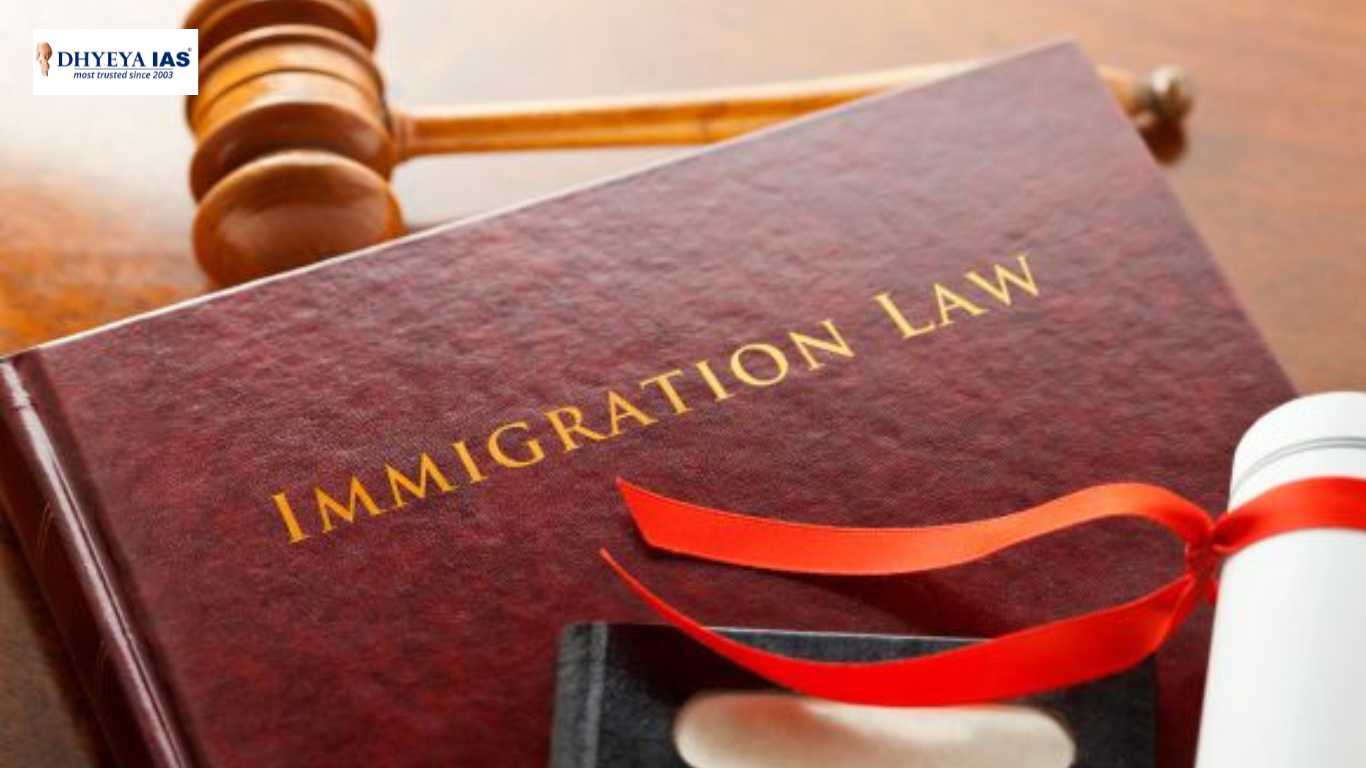Context: Immigration has long been a subject of critical policy deliberation in India, impacting national security, demographic composition, economic opportunities, and international relations. As globalization accelerates and cross-border movements become more frequent, regulating the entry, stay, and exit of foreign nationals has emerged as a pressing challenge.
Recognizing the need for a modernized, structured, and stringent legal framework, the Union Government, has introduced the Immigration and Foreigners Bill, 2025. This legislative proposal, which was listed among 16 key bills for the Budget Session of Parliament (January 31 – April 4, 2025), seeks to replace and consolidate multiple outdated laws governing immigration into a single, cohesive framework.
Currently, India’s immigration policies are governed by three colonial-era laws:
- The Foreigners Act, 1946
- The Passport (Entry into India) Act, 1920
- The Registration of Foreigners Act, 1939
These laws were formulated at a time when global migration patterns, national security concerns, and diplomatic considerations were vastly different. The Immigration and Foreigners Bill, 2025, therefore, aims to streamline enforcement, close legal loopholes, and modernize immigration regulations to meet contemporary needs.
The bill assumes significance in the wake of rising visa violations, illegal border crossings, and increasing security concerns, necessitating a centralized approach to managing foreign nationals within India’s borders.
Objectives and Scope of the Immigration and Foreigners Bill, 2025
The primary objectives of the bill are:
- Regulation of Foreign Nationals: Establishing clear guidelines on passport and visa requirements for individuals seeking entry into India.
- Monitoring and Registration: Creating a robust mechanism for tracking the presence of foreign nationals to prevent visa overstays and illegal migration.
- Movement Restrictions and Security Provisions: Authorizing restrictions on the movement of certain categories of foreigners based on national security concerns.
- Enforcement of Deportation: Establishing clear legal procedures for the deportation of foreigners violating immigration laws.
Additionally, the bill places specific responsibilities on institutions that interact with foreign nationals, ensuring greater compliance. These include:
- Educational institutions, hospitals, hotels, and airlines, which will be required to maintain and report records of foreign nationals under their jurisdiction.
- Transport operators (airlines, shipping companies, and railways), which will be held responsible for ensuring that all incoming passengers possess valid travel documents.
By unifying fragmented immigration laws, the bill aims to simplify enforcement, reduce administrative inefficiencies, and enhance border security.
Key Provisions of the Immigration and Foreigners Bill, 2025
1. Centralized Immigration Control
- The bill proposes the establishment of a single centralized agency to oversee all immigration-related matters, ensuring uniform implementation and enforcement of laws across India.
- A national digital database will be created to track entries, exits, and visa compliance of foreign nationals.
2. Visa and Passport Regulations
- Foreign nationals will be required to possess valid passports and visas before entering India.
- Hotels, universities, and hospitals will be legally mandated to report the presence of foreign visitors, students, and patients to authorities.
3. Responsibilities of Transport Operators
- Airlines, shipping companies, and railways must verify passengers' travel documents before allowing entry.
- If a foreign national is denied entry upon arrival, the responsibility for their immediate removal falls on the carrier that transported them.
- Penalties and legal action will be imposed on carriers that fail to enforce these regulations.
4. Restrictions on Foreigners
- Foreign nationals cannot change their names while residing in India without government approval.
- Authorities may impose movement restrictions on individuals deemed security threats.
5. Strengthened Enforcement Mechanisms
- District Magistrates, Police Commissioners, and Immigration Officers will have expanded powers to monitor, detain, and deport foreigners violating immigration laws.
- Offenders may face fines, imprisonment, or deportation based on the severity of violations.
6. Deportation and Removal Procedures
- The Union Government will have the authority to deport foreign nationals who violate visa conditions or pose a threat to national security.
- Transport carriers will bear responsibility for removing foreigners denied entry upon arrival.
By introducing structured enforcement mechanisms, the bill aims to streamline immigration control and improve national security.
|
Illegal Immigration from India: Scale and Trends While India faces challenges with illegal immigration, it is also a significant source of undocumented migration to countries such as the United States, Canada, and Europe. Estimates suggest that over 725,000 undocumented Indian migrants currently reside in the U.S. alone. Recent Trends in Deportations · Between June and October 2024, 160,000 individuals were deported globally, including over 1,000 Indian nationals. · The U.S. has intensified mass deportations, particularly targeting migrants from Punjab, Haryana, and Gujarat. · Many Indian migrants now prefer entering the U.S. through Canada, as Canada offers faster visa processing (76 days compared to over a year for the U.S.). |
Methods of Illegal Migration from India
1. Visa Overstays
- Many Indians enter legally but fail to return after their visas expire.
- Student and work visas are often misused to seek unauthorized employment.
2. Unauthorized Border Crossings
- The "Dunki Route" involves fake visas, human smugglers, and dangerous border crossings.
- The Darién Gap (Panama-Colombia) remains a high-risk route used by Indian migrants heading to the U.S. illegally.
- Many migrants illegally enter the U.S. via Canada, where entry restrictions are less strict.
3. Marriage and Birthright Citizenship Fraud
- Fake marriages are arranged to obtain permanent residency in foreign countries.
- Birth tourism is used to secure automatic U.S. citizenship for children born to Indian parents in the U.S.
Underlying Causes of Illegal Immigration from India
- Economic Disparity: Higher wages in the U.S. ($10–15 per hour) attract migrants despite risks.
- Agricultural Crisis: Farmers in Punjab and Haryana often sell their land to finance illegal migration.
- Human Trafficking: India is among the top 10 countries for human trafficking victims.
- Bureaucratic Barriers: 600+ day U.S. visa wait times push individuals toward illegal migration.
Implications of the Immigration and Foreigners Bill, 2025
If passed, the bill will reshape India’s immigration system, leading to:
- Stronger enforcement of immigration laws, reducing visa violations.
- Improved national security, preventing unauthorized migration.
- Better diplomatic relations by ensuring adherence to international immigration norms.
The bill will also affect:
- Foreign workers, students, and tourists in India.
- India’s relations with nations with large Indian immigrant populations (e.g., U.S., Canada, UK).
- Security measures against illegal immigration, particularly from Bangladesh and Myanmar (Rohingya refugees).
As India positions itself as a global economic and political power, the Immigration and Foreigners Bill, 2025, will serve as a critical instrument in shaping future immigration policies and enhancing border security.
| Main question: Evaluate the role of various institutions, such as educational establishments, hospitals, and transport operators, in enforcing the provisions of the Immigration and Foreigners Bill, 2025. How might these responsibilities impact their operations? |
Source: The Economic Times








